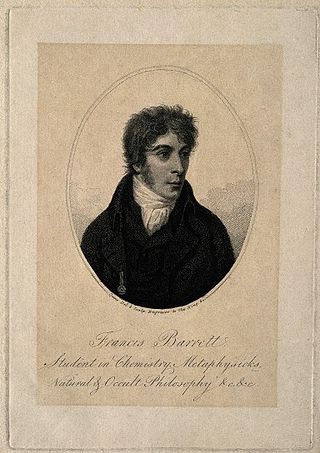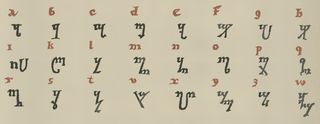
The Magus, or Celestial Intelligencer is a handbook of the occult and ceremonial magic compiled by occultist Francis Barrett published in 1801.

The Magus, or Celestial Intelligencer is a handbook of the occult and ceremonial magic compiled by occultist Francis Barrett published in 1801.
Much of the material was collected by Barrett from older occult handbooks, as he hints in the preface:
We have collected out of the works of the most famous magicians, such as Zoroaster, Hermes, Apollonius, Simon of the Temple, Trithemius, Agrippa, Porta (the Neapolitan), Dee, Paracelsus, Roger Bacon, and a great many others...
In fact, most of the material comes from Agrippa's Three Books of Occult Philosophy and Pietro d'Abano's Heptameron. [1]
Previous demonologists such as Binsfeld (1589) had drawn up lists that comprised a hierarchy of devils, and attributed to them the power to instigate people to commit the seven deadly sins. Lucifer was associated with Pride, Satan with Anger and so forth. In The Magus Barrett altered the "roster of devils" and Satan now became a prince of deluders (serving conjurers and witches).
The book was originally published with two books in a single volume, as was common with many texts of this period. It facilitated the modern revival of magic by making information from otherwise rare books more readily available.

A grimoire is a textbook of magic, typically including instructions on how to create magical objects like talismans and amulets, how to perform magical spells, charms, and divination, and how to summon or invoke supernatural entities such as angels, spirits, deities, and demons. In many cases, the books themselves are believed to be imbued with magical powers. The only contents found in a grimoire would be information on spells, rituals, the preparation of magical tools, and lists of ingredients and their magical correspondences. In this manner, while all books on magic could be thought of as grimoires, not all magical books should be thought of as grimoires.

The Temple of Set is an occult initiatory order founded in 1975. A new religious movement and form of Western esotericism, the Temple espouses a religion known as Setianism, whose practitioners are called Setians. This is sometimes identified as a form of Satanism, although this term is not often embraced by Setians and is contested by some academics.

The Church of Satan (CoS) is a religious organization dedicated to the religion of Satanism as defined by Anton Szandor LaVey. Founded in San Francisco in 1966, by LaVey, it is considered the "oldest satanic religion in continual existence", and more importantly the most influential, inspiring "numerous imitator and breakaway groups". According to the Church, Satanism has been "codified" as "a religion and philosophy" by LaVey and his church. Founded in an era when there was much public interest in the occult, witchcraft and Satanism, the church enjoyed a heyday for several years after its founding. Celebrities attended LaVey's satanic parties and he was invited on talk shows. His Satanic Bible sold nearly a million copies.

Pietro d'Abano, also known as Petrus de Apono, Petrus Aponensis or Peter of Abano, was an Italian philosopher, astrologer, and professor of medicine in Padua. He was born in the Italian town from which he takes his name, now Abano Terme. He gained fame by writing Conciliator Differentiarum, quae inter Philosophos et Medicos Versantur. He was eventually accused of heresy and atheism, and came before the Inquisition. He died in prison in 1315 before the end of his trial.

Heinrich Cornelius Agrippa von Nettesheim was a German Renaissance polymath, physician, legal scholar, soldier, knight, theologian, and occult writer. Agrippa's Three Books of Occult Philosophy published in 1533 drew heavily upon Kabbalah, Hermeticism, and Neoplatonism. His book was widely influential among esotericists of the early modern period, and was condemned as heretical by the inquisitor of Cologne.

Ceremonial magic encompasses a wide variety of rituals of magic. The works included are characterized by ceremony and numerous requisite accessories to aid the practitioner. It can be seen as an extension of ritual magic, and in most cases synonymous with it. Popularized by the Hermetic Order of the Golden Dawn, it draws on such schools of philosophical and occult thought as Hermetic Qabalah, Enochian magic, Thelema, and the magic of various grimoires. Ceremonial magic is part of Hermeticism and Western esotericism.

A pentacle is a talisman that is used in magical evocation, and is usually made of parchment, paper, cloth, or metal, upon which a magical design is drawn. Symbols may also be included, a common one being the six-point form of the Seal of Solomon.

Anton Szandor LaVey was an American author, musician, and LaVeyan Satanist. He was the founder of the Church of Satan, the philosophy of LaVeyan Satanism, and the concept of Satanism. He authored several books, including The Satanic Bible, The Satanic Rituals, The Satanic Witch, The Devil's Notebook, and Satan Speaks! In addition, he released three albums, including The Satanic Mass, Satan Takes a Holiday, and Strange Music. He played a minor on-screen role and served as technical advisor for the 1975 film The Devil's Rain and served as host and narrator for Nick Bougas' 1989 mondo film Death Scenes.
The Lesser Key of Solomon, also known by its Latin title Lemegeton Clavicula Salomonis or simply the Lemegeton, is an anonymously authored grimoire on sorcery, mysticism and magic. It was compiled in the mid-17th century, mostly from materials several centuries older. It is divided into five books: the Ars Goetia, Ars Theurgia-Goetia, Ars Paulina, Ars Almadel, and Ars Notoria. It is based on the Testament of Solomon and the ring mentioned within it that he used to seal demons.
Coscinomancy is a form of divination utilising a sieve and shears, used in ancient Greece, medieval and early modern Europe and 17th century New England, to determine the guilty party in a criminal offense, find answers to questions, etc.

There have been various attempts at the classification of demons within the contexts of classical mythology, demonology, occultism, and Renaissance magic. These classifications may be for purposes of traditional medicine, exorcisms, ceremonial magic, witch-hunts, lessons in morality, folklore, religious ritual, or combinations thereof. Classifications might be according to astrological connections, elemental forms, noble titles, or parallels to the angelic hierarchy; or by association with particular sins, diseases, and other calamities; or by what angel or saint opposes them.

Three Books of Occult Philosophy is Heinrich Cornelius Agrippa's study of occult philosophy, acknowledged as a significant contribution to the Renaissance philosophical discussion concerning the powers of magic, and its relationship with religion. The first book was printed in 1531 in Paris, Cologne, and Antwerp, while the full three volumes first appeared in Cologne in 1533.

Francis Barrett was an English occultist.

The Theban alphabet, also known as the witches' alphabet, is a writing system, specifically a substitution cipher of the Latin script, that was used by early modern occultists and is popular in the Wicca movement.

The Arbatel De Magia Veterum is a Latin grimoire of Renaissance ceremonial magic published in 1575 in Switzerland.

Theistic Satanism, otherwise referred to as traditional Satanism, religious Satanism, or spiritual Satanism, is an umbrella term for religious groups that consider Satan, the Devil, to objectively exist as a deity, supernatural entity, or spiritual being worthy of worship or reverence, whom individuals may believe in, contact, and convene with, in contrast to the atheistic archetype, metaphor, or symbol found in LaVeyan Satanism.
Natural magic in the context of Renaissance magic is that part of the occult which deals with natural forces directly, as opposed to ceremonial magic which deals with the summoning of spirits. Natural magic sometimes makes use of physical substances from the natural world such as stones or herbs.

Hermetic Qabalah is a Western esoteric tradition involving mysticism and the occult. It is the underlying philosophy and framework for magical societies such as the Hermetic Order of the Golden Dawn, has inspired esoteric Masonic organizations such as the Societas Rosicruciana in Anglia, is a key element within the Thelemic orders, and is important to mystical-religious societies such as the Builders of the Adytum and the Fellowship of the Rosy Cross.

Frederick Hockley was a British occultist and scryer who was a London-based Freemason and a member of the Societas Rosicruciana in Anglia.
Liber Officiorum Spirituum was a goetic grimoire and a major source for Johann Weyer's Pseudomonarchia Daemonum and the Ars Goetia. The original work has not been located, but some derived texts bearing the title have been found, some in the Sloane manuscripts, some in the Folger Shakespeare Library. Each version bears many similarities to each other and to the Pseudomonarchia Daemonum and the Ars Goetia, though they are far from identical.